Taxation Law Assignment: Exploring Deductions, GST, and Legal Expenses
VerifiedAdded on 2020/03/23
|12
|1998
|47
Homework Assignment
AI Summary
This taxation law assignment addresses several key issues related to income tax deductions and GST in the context of Australian tax law. The assignment begins by examining allowable deductions under section 8-1 of the ITAA 1997, focusing on the deductibility of costs associated with shifting machinery, asset revaluation for insurance cover, legal expenses related to business wind-up, and legal disbursements for various business operations. It analyzes these scenarios in light of relevant legislation and case law, such as the British Insulated & Helsby Cables case and the taxation ruling of TD 93/126. The second part of the assignment focuses on GST, specifically addressing the input tax credit for a financial institution's advertising expenditures, differentiating between expenses related to current services and new product launches. The assignment concludes with a calculation of the input tax credit allowed to the bank. The document provides a comprehensive analysis of taxation principles and their application to practical business scenarios.
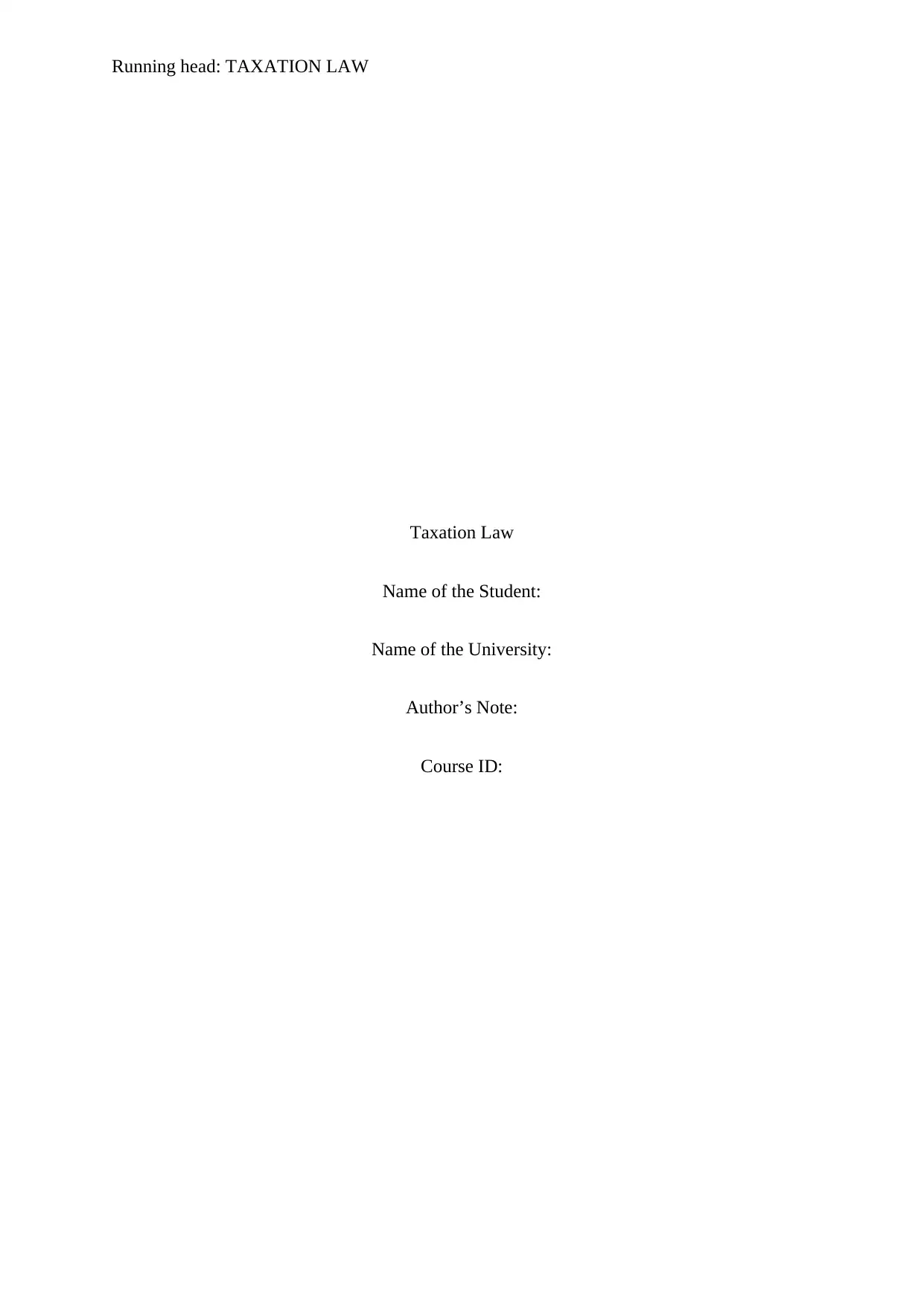
Running head: TAXATION LAW
Taxation Law
Name of the Student:
Name of the University:
Author’s Note:
Course ID:
Taxation Law
Name of the Student:
Name of the University:
Author’s Note:
Course ID:
Paraphrase This Document
Need a fresh take? Get an instant paraphrase of this document with our AI Paraphraser
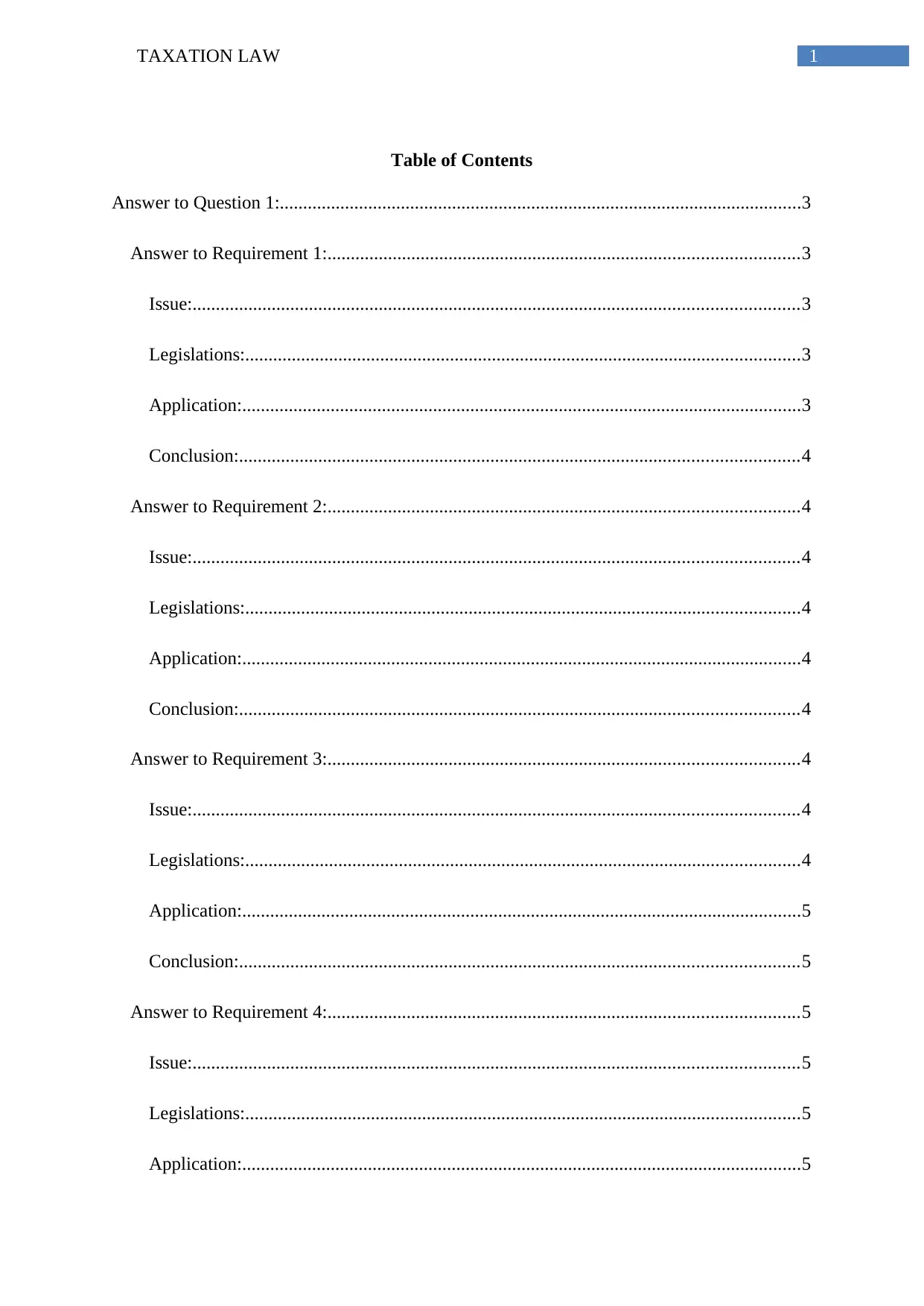
1TAXATION LAW
Table of Contents
Answer to Question 1:................................................................................................................3
Answer to Requirement 1:.....................................................................................................3
Issue:..................................................................................................................................3
Legislations:.......................................................................................................................3
Application:........................................................................................................................3
Conclusion:........................................................................................................................4
Answer to Requirement 2:.....................................................................................................4
Issue:..................................................................................................................................4
Legislations:.......................................................................................................................4
Application:........................................................................................................................4
Conclusion:........................................................................................................................4
Answer to Requirement 3:.....................................................................................................4
Issue:..................................................................................................................................4
Legislations:.......................................................................................................................4
Application:........................................................................................................................5
Conclusion:........................................................................................................................5
Answer to Requirement 4:.....................................................................................................5
Issue:..................................................................................................................................5
Legislations:.......................................................................................................................5
Application:........................................................................................................................5
Table of Contents
Answer to Question 1:................................................................................................................3
Answer to Requirement 1:.....................................................................................................3
Issue:..................................................................................................................................3
Legislations:.......................................................................................................................3
Application:........................................................................................................................3
Conclusion:........................................................................................................................4
Answer to Requirement 2:.....................................................................................................4
Issue:..................................................................................................................................4
Legislations:.......................................................................................................................4
Application:........................................................................................................................4
Conclusion:........................................................................................................................4
Answer to Requirement 3:.....................................................................................................4
Issue:..................................................................................................................................4
Legislations:.......................................................................................................................4
Application:........................................................................................................................5
Conclusion:........................................................................................................................5
Answer to Requirement 4:.....................................................................................................5
Issue:..................................................................................................................................5
Legislations:.......................................................................................................................5
Application:........................................................................................................................5
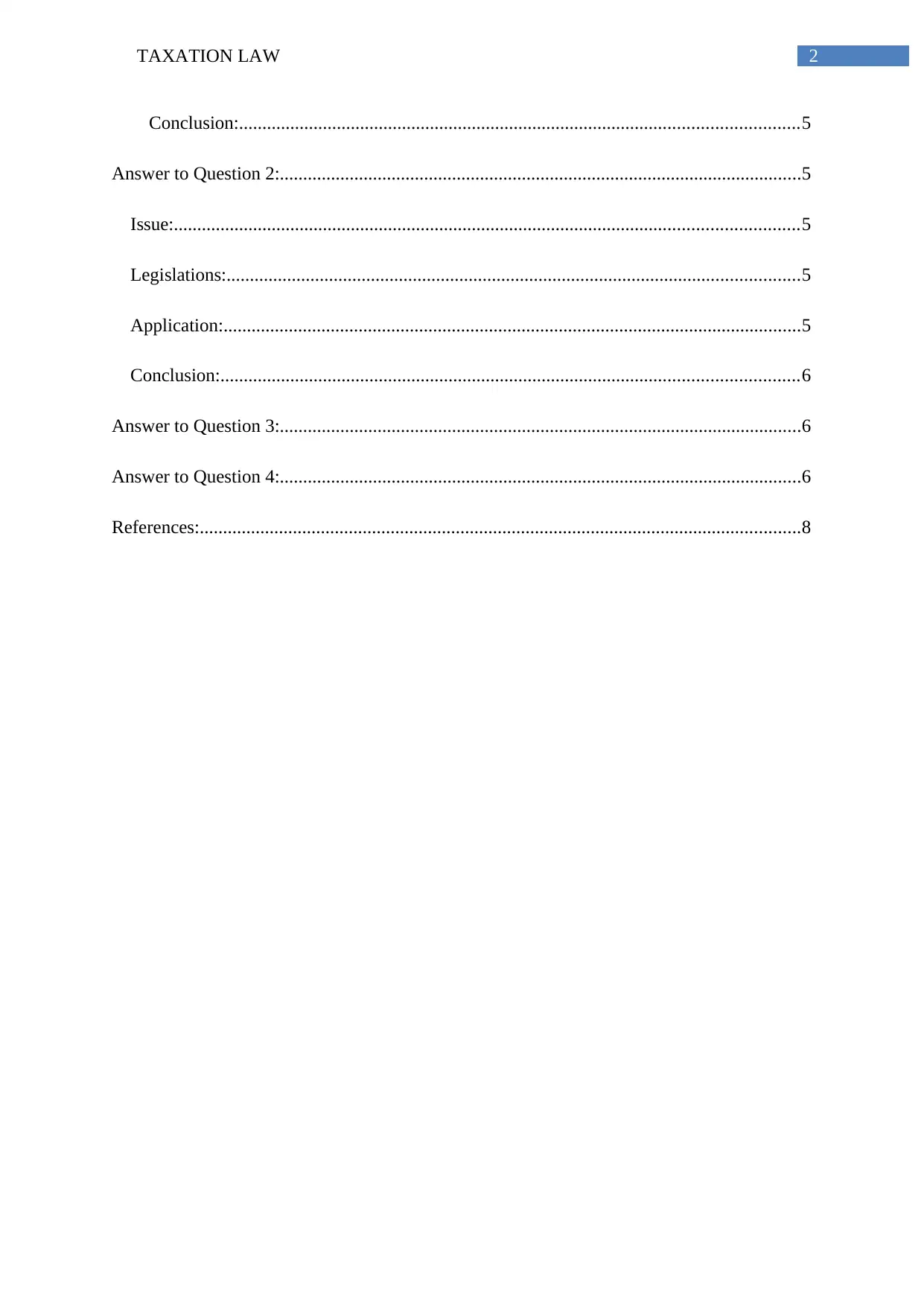
2TAXATION LAW
Conclusion:........................................................................................................................5
Answer to Question 2:................................................................................................................5
Issue:......................................................................................................................................5
Legislations:...........................................................................................................................5
Application:............................................................................................................................5
Conclusion:............................................................................................................................6
Answer to Question 3:................................................................................................................6
Answer to Question 4:................................................................................................................6
References:.................................................................................................................................8
Conclusion:........................................................................................................................5
Answer to Question 2:................................................................................................................5
Issue:......................................................................................................................................5
Legislations:...........................................................................................................................5
Application:............................................................................................................................5
Conclusion:............................................................................................................................6
Answer to Question 3:................................................................................................................6
Answer to Question 4:................................................................................................................6
References:.................................................................................................................................8
⊘ This is a preview!⊘
Do you want full access?
Subscribe today to unlock all pages.

Trusted by 1+ million students worldwide
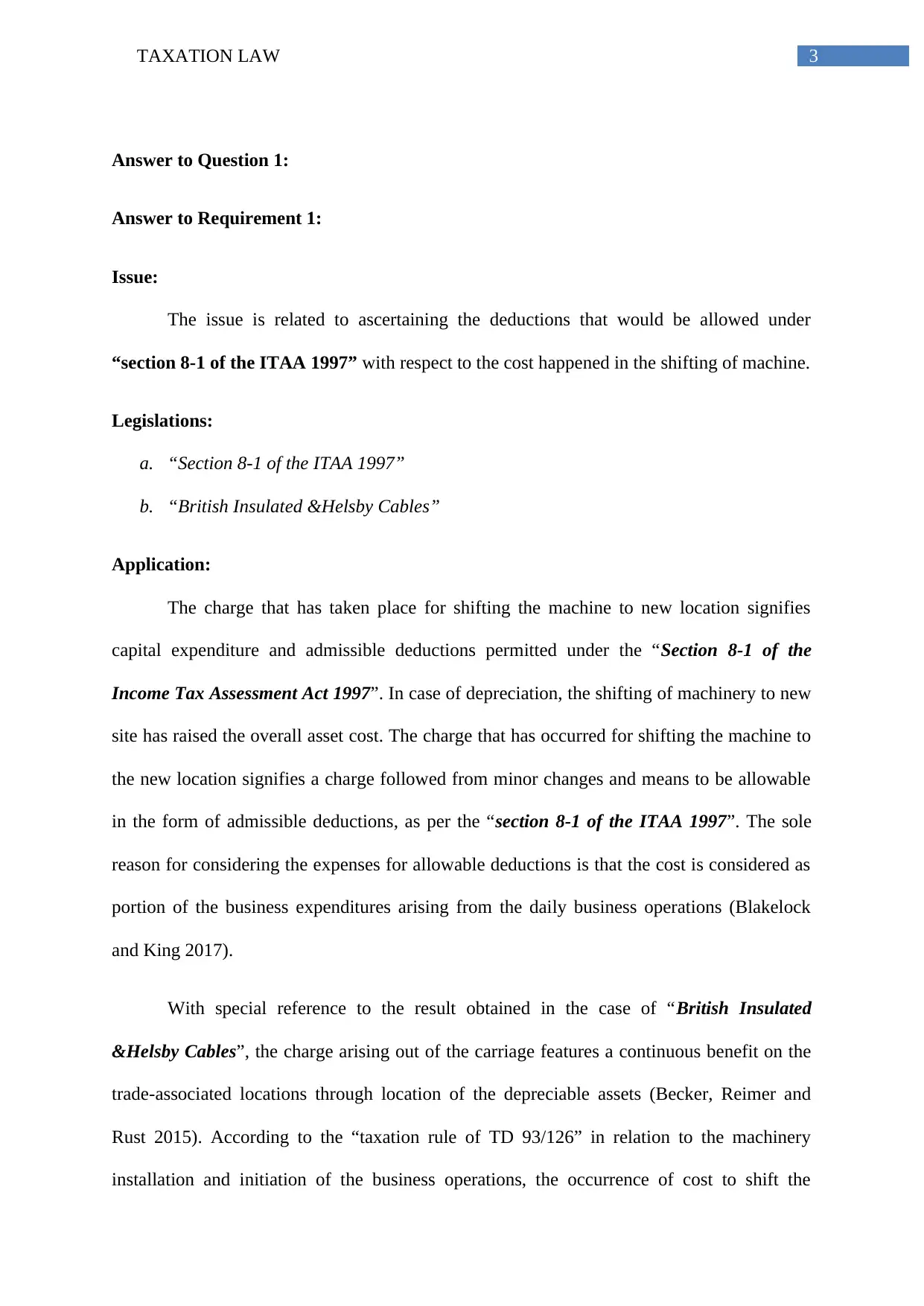
3TAXATION LAW
Answer to Question 1:
Answer to Requirement 1:
Issue:
The issue is related to ascertaining the deductions that would be allowed under
“section 8-1 of the ITAA 1997” with respect to the cost happened in the shifting of machine.
Legislations:
a. “Section 8-1 of the ITAA 1997”
b. “British Insulated &Helsby Cables”
Application:
The charge that has taken place for shifting the machine to new location signifies
capital expenditure and admissible deductions permitted under the “Section 8-1 of the
Income Tax Assessment Act 1997”. In case of depreciation, the shifting of machinery to new
site has raised the overall asset cost. The charge that has occurred for shifting the machine to
the new location signifies a charge followed from minor changes and means to be allowable
in the form of admissible deductions, as per the “section 8-1 of the ITAA 1997”. The sole
reason for considering the expenses for allowable deductions is that the cost is considered as
portion of the business expenditures arising from the daily business operations (Blakelock
and King 2017).
With special reference to the result obtained in the case of “British Insulated
&Helsby Cables”, the charge arising out of the carriage features a continuous benefit on the
trade-associated locations through location of the depreciable assets (Becker, Reimer and
Rust 2015). According to the “taxation rule of TD 93/126” in relation to the machinery
installation and initiation of the business operations, the occurrence of cost to shift the
Answer to Question 1:
Answer to Requirement 1:
Issue:
The issue is related to ascertaining the deductions that would be allowed under
“section 8-1 of the ITAA 1997” with respect to the cost happened in the shifting of machine.
Legislations:
a. “Section 8-1 of the ITAA 1997”
b. “British Insulated &Helsby Cables”
Application:
The charge that has taken place for shifting the machine to new location signifies
capital expenditure and admissible deductions permitted under the “Section 8-1 of the
Income Tax Assessment Act 1997”. In case of depreciation, the shifting of machinery to new
site has raised the overall asset cost. The charge that has occurred for shifting the machine to
the new location signifies a charge followed from minor changes and means to be allowable
in the form of admissible deductions, as per the “section 8-1 of the ITAA 1997”. The sole
reason for considering the expenses for allowable deductions is that the cost is considered as
portion of the business expenditures arising from the daily business operations (Blakelock
and King 2017).
With special reference to the result obtained in the case of “British Insulated
&Helsby Cables”, the charge arising out of the carriage features a continuous benefit on the
trade-associated locations through location of the depreciable assets (Becker, Reimer and
Rust 2015). According to the “taxation rule of TD 93/126” in relation to the machinery
installation and initiation of the business operations, the occurrence of cost to shift the
Paraphrase This Document
Need a fresh take? Get an instant paraphrase of this document with our AI Paraphraser
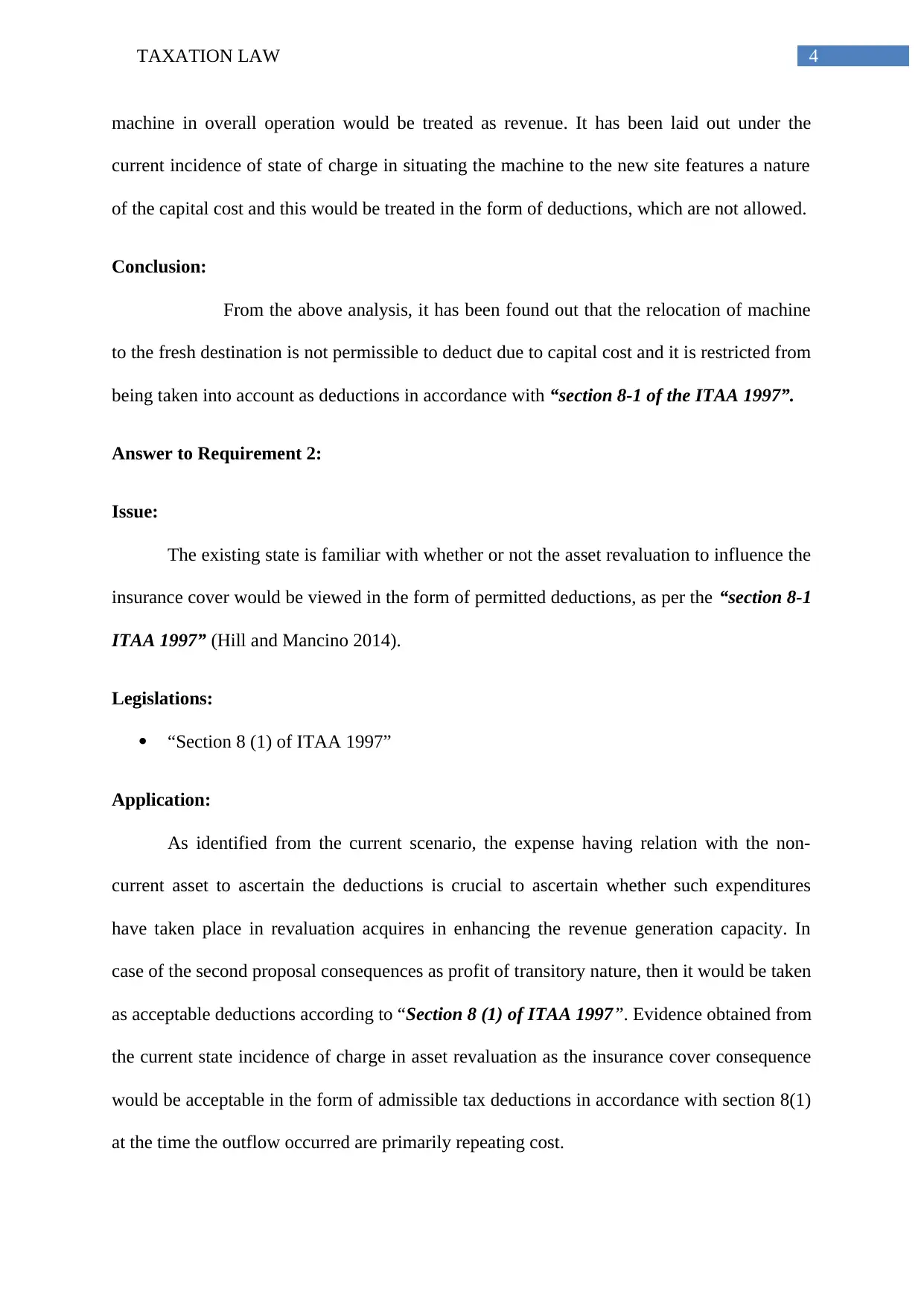
4TAXATION LAW
machine in overall operation would be treated as revenue. It has been laid out under the
current incidence of state of charge in situating the machine to the new site features a nature
of the capital cost and this would be treated in the form of deductions, which are not allowed.
Conclusion:
From the above analysis, it has been found out that the relocation of machine
to the fresh destination is not permissible to deduct due to capital cost and it is restricted from
being taken into account as deductions in accordance with “section 8-1 of the ITAA 1997”.
Answer to Requirement 2:
Issue:
The existing state is familiar with whether or not the asset revaluation to influence the
insurance cover would be viewed in the form of permitted deductions, as per the “section 8-1
ITAA 1997” (Hill and Mancino 2014).
Legislations:
“Section 8 (1) of ITAA 1997”
Application:
As identified from the current scenario, the expense having relation with the non-
current asset to ascertain the deductions is crucial to ascertain whether such expenditures
have taken place in revaluation acquires in enhancing the revenue generation capacity. In
case of the second proposal consequences as profit of transitory nature, then it would be taken
as acceptable deductions according to “Section 8 (1) of ITAA 1997”. Evidence obtained from
the current state incidence of charge in asset revaluation as the insurance cover consequence
would be acceptable in the form of admissible tax deductions in accordance with section 8(1)
at the time the outflow occurred are primarily repeating cost.
machine in overall operation would be treated as revenue. It has been laid out under the
current incidence of state of charge in situating the machine to the new site features a nature
of the capital cost and this would be treated in the form of deductions, which are not allowed.
Conclusion:
From the above analysis, it has been found out that the relocation of machine
to the fresh destination is not permissible to deduct due to capital cost and it is restricted from
being taken into account as deductions in accordance with “section 8-1 of the ITAA 1997”.
Answer to Requirement 2:
Issue:
The existing state is familiar with whether or not the asset revaluation to influence the
insurance cover would be viewed in the form of permitted deductions, as per the “section 8-1
ITAA 1997” (Hill and Mancino 2014).
Legislations:
“Section 8 (1) of ITAA 1997”
Application:
As identified from the current scenario, the expense having relation with the non-
current asset to ascertain the deductions is crucial to ascertain whether such expenditures
have taken place in revaluation acquires in enhancing the revenue generation capacity. In
case of the second proposal consequences as profit of transitory nature, then it would be taken
as acceptable deductions according to “Section 8 (1) of ITAA 1997”. Evidence obtained from
the current state incidence of charge in asset revaluation as the insurance cover consequence
would be acceptable in the form of admissible tax deductions in accordance with section 8(1)
at the time the outflow occurred are primarily repeating cost.
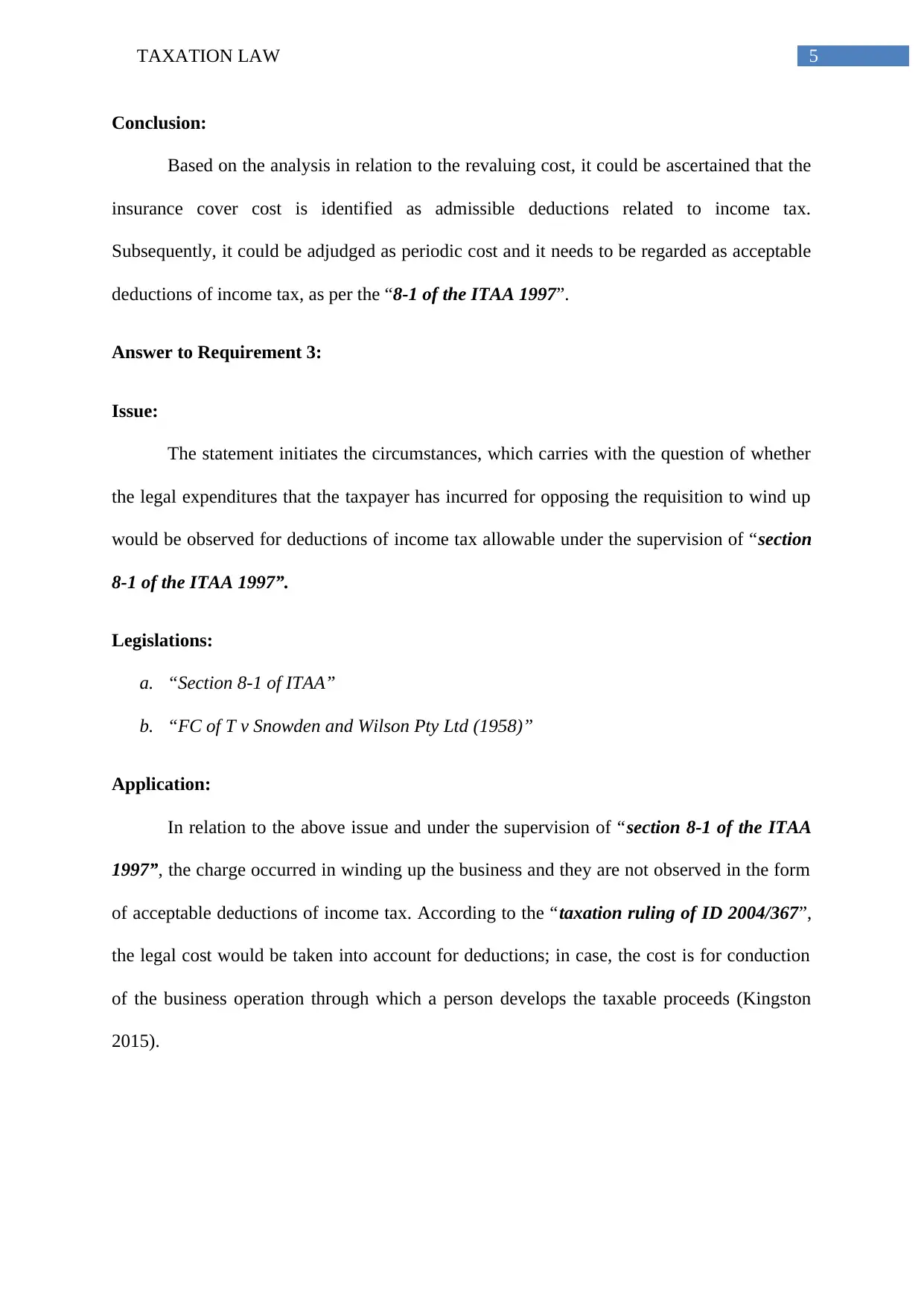
5TAXATION LAW
Conclusion:
Based on the analysis in relation to the revaluing cost, it could be ascertained that the
insurance cover cost is identified as admissible deductions related to income tax.
Subsequently, it could be adjudged as periodic cost and it needs to be regarded as acceptable
deductions of income tax, as per the “8-1 of the ITAA 1997”.
Answer to Requirement 3:
Issue:
The statement initiates the circumstances, which carries with the question of whether
the legal expenditures that the taxpayer has incurred for opposing the requisition to wind up
would be observed for deductions of income tax allowable under the supervision of “section
8-1 of the ITAA 1997”.
Legislations:
a. “Section 8-1 of ITAA”
b. “FC of T v Snowden and Wilson Pty Ltd (1958)”
Application:
In relation to the above issue and under the supervision of “section 8-1 of the ITAA
1997”, the charge occurred in winding up the business and they are not observed in the form
of acceptable deductions of income tax. According to the “taxation ruling of ID 2004/367”,
the legal cost would be taken into account for deductions; in case, the cost is for conduction
of the business operation through which a person develops the taxable proceeds (Kingston
2015).
Conclusion:
Based on the analysis in relation to the revaluing cost, it could be ascertained that the
insurance cover cost is identified as admissible deductions related to income tax.
Subsequently, it could be adjudged as periodic cost and it needs to be regarded as acceptable
deductions of income tax, as per the “8-1 of the ITAA 1997”.
Answer to Requirement 3:
Issue:
The statement initiates the circumstances, which carries with the question of whether
the legal expenditures that the taxpayer has incurred for opposing the requisition to wind up
would be observed for deductions of income tax allowable under the supervision of “section
8-1 of the ITAA 1997”.
Legislations:
a. “Section 8-1 of ITAA”
b. “FC of T v Snowden and Wilson Pty Ltd (1958)”
Application:
In relation to the above issue and under the supervision of “section 8-1 of the ITAA
1997”, the charge occurred in winding up the business and they are not observed in the form
of acceptable deductions of income tax. According to the “taxation ruling of ID 2004/367”,
the legal cost would be taken into account for deductions; in case, the cost is for conduction
of the business operation through which a person develops the taxable proceeds (Kingston
2015).
⊘ This is a preview!⊘
Do you want full access?
Subscribe today to unlock all pages.

Trusted by 1+ million students worldwide
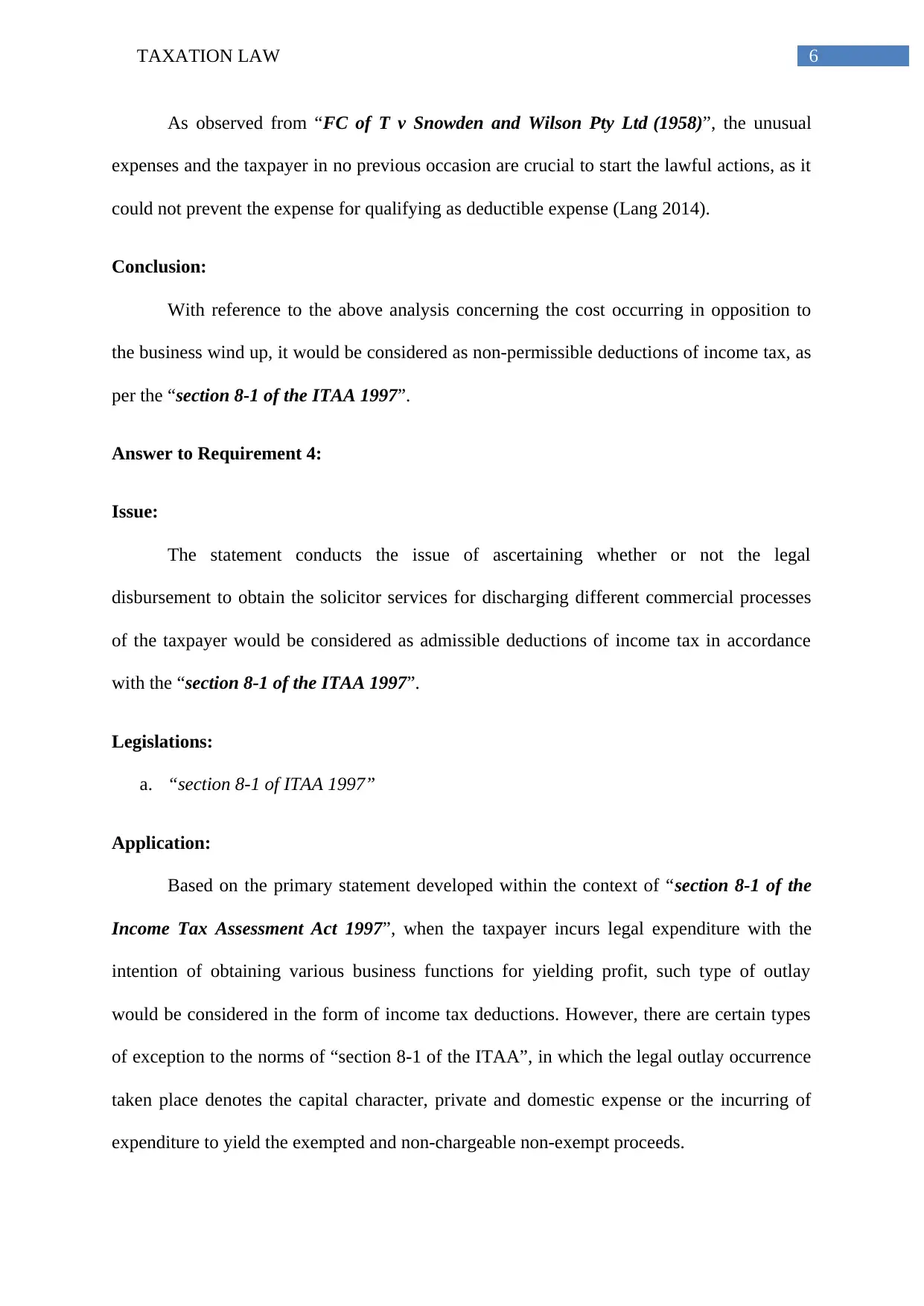
6TAXATION LAW
As observed from “FC of T v Snowden and Wilson Pty Ltd (1958)”, the unusual
expenses and the taxpayer in no previous occasion are crucial to start the lawful actions, as it
could not prevent the expense for qualifying as deductible expense (Lang 2014).
Conclusion:
With reference to the above analysis concerning the cost occurring in opposition to
the business wind up, it would be considered as non-permissible deductions of income tax, as
per the “section 8-1 of the ITAA 1997”.
Answer to Requirement 4:
Issue:
The statement conducts the issue of ascertaining whether or not the legal
disbursement to obtain the solicitor services for discharging different commercial processes
of the taxpayer would be considered as admissible deductions of income tax in accordance
with the “section 8-1 of the ITAA 1997”.
Legislations:
a. “section 8-1 of ITAA 1997”
Application:
Based on the primary statement developed within the context of “section 8-1 of the
Income Tax Assessment Act 1997”, when the taxpayer incurs legal expenditure with the
intention of obtaining various business functions for yielding profit, such type of outlay
would be considered in the form of income tax deductions. However, there are certain types
of exception to the norms of “section 8-1 of the ITAA”, in which the legal outlay occurrence
taken place denotes the capital character, private and domestic expense or the incurring of
expenditure to yield the exempted and non-chargeable non-exempt proceeds.
As observed from “FC of T v Snowden and Wilson Pty Ltd (1958)”, the unusual
expenses and the taxpayer in no previous occasion are crucial to start the lawful actions, as it
could not prevent the expense for qualifying as deductible expense (Lang 2014).
Conclusion:
With reference to the above analysis concerning the cost occurring in opposition to
the business wind up, it would be considered as non-permissible deductions of income tax, as
per the “section 8-1 of the ITAA 1997”.
Answer to Requirement 4:
Issue:
The statement conducts the issue of ascertaining whether or not the legal
disbursement to obtain the solicitor services for discharging different commercial processes
of the taxpayer would be considered as admissible deductions of income tax in accordance
with the “section 8-1 of the ITAA 1997”.
Legislations:
a. “section 8-1 of ITAA 1997”
Application:
Based on the primary statement developed within the context of “section 8-1 of the
Income Tax Assessment Act 1997”, when the taxpayer incurs legal expenditure with the
intention of obtaining various business functions for yielding profit, such type of outlay
would be considered in the form of income tax deductions. However, there are certain types
of exception to the norms of “section 8-1 of the ITAA”, in which the legal outlay occurrence
taken place denotes the capital character, private and domestic expense or the incurring of
expenditure to yield the exempted and non-chargeable non-exempt proceeds.
Paraphrase This Document
Need a fresh take? Get an instant paraphrase of this document with our AI Paraphraser
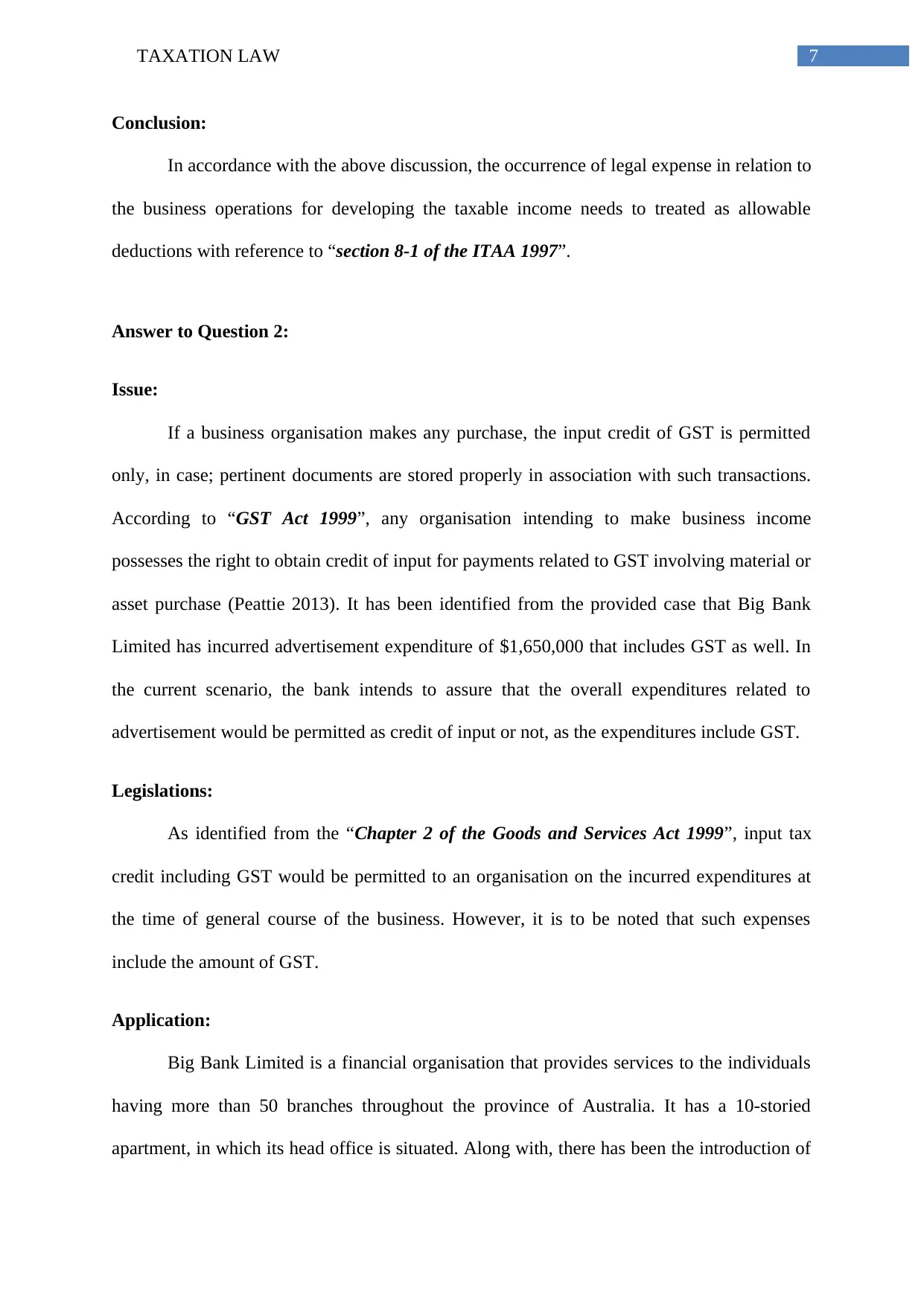
7TAXATION LAW
Conclusion:
In accordance with the above discussion, the occurrence of legal expense in relation to
the business operations for developing the taxable income needs to treated as allowable
deductions with reference to “section 8-1 of the ITAA 1997”.
Answer to Question 2:
Issue:
If a business organisation makes any purchase, the input credit of GST is permitted
only, in case; pertinent documents are stored properly in association with such transactions.
According to “GST Act 1999”, any organisation intending to make business income
possesses the right to obtain credit of input for payments related to GST involving material or
asset purchase (Peattie 2013). It has been identified from the provided case that Big Bank
Limited has incurred advertisement expenditure of $1,650,000 that includes GST as well. In
the current scenario, the bank intends to assure that the overall expenditures related to
advertisement would be permitted as credit of input or not, as the expenditures include GST.
Legislations:
As identified from the “Chapter 2 of the Goods and Services Act 1999”, input tax
credit including GST would be permitted to an organisation on the incurred expenditures at
the time of general course of the business. However, it is to be noted that such expenses
include the amount of GST.
Application:
Big Bank Limited is a financial organisation that provides services to the individuals
having more than 50 branches throughout the province of Australia. It has a 10-storied
apartment, in which its head office is situated. Along with, there has been the introduction of
Conclusion:
In accordance with the above discussion, the occurrence of legal expense in relation to
the business operations for developing the taxable income needs to treated as allowable
deductions with reference to “section 8-1 of the ITAA 1997”.
Answer to Question 2:
Issue:
If a business organisation makes any purchase, the input credit of GST is permitted
only, in case; pertinent documents are stored properly in association with such transactions.
According to “GST Act 1999”, any organisation intending to make business income
possesses the right to obtain credit of input for payments related to GST involving material or
asset purchase (Peattie 2013). It has been identified from the provided case that Big Bank
Limited has incurred advertisement expenditure of $1,650,000 that includes GST as well. In
the current scenario, the bank intends to assure that the overall expenditures related to
advertisement would be permitted as credit of input or not, as the expenditures include GST.
Legislations:
As identified from the “Chapter 2 of the Goods and Services Act 1999”, input tax
credit including GST would be permitted to an organisation on the incurred expenditures at
the time of general course of the business. However, it is to be noted that such expenses
include the amount of GST.
Application:
Big Bank Limited is a financial organisation that provides services to the individuals
having more than 50 branches throughout the province of Australia. It has a 10-storied
apartment, in which its head office is situated. Along with, there has been the introduction of
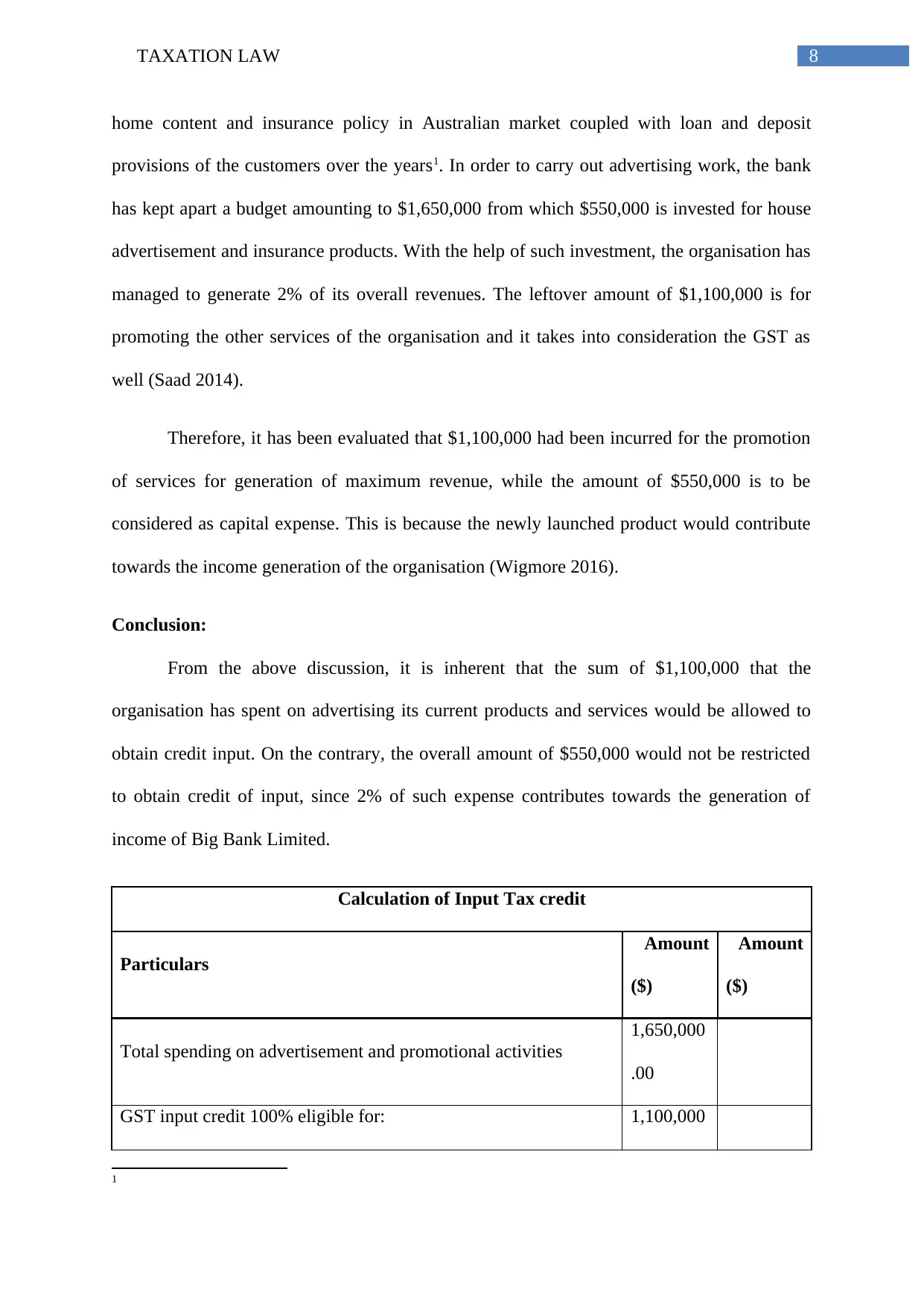
8TAXATION LAW
home content and insurance policy in Australian market coupled with loan and deposit
provisions of the customers over the years1. In order to carry out advertising work, the bank
has kept apart a budget amounting to $1,650,000 from which $550,000 is invested for house
advertisement and insurance products. With the help of such investment, the organisation has
managed to generate 2% of its overall revenues. The leftover amount of $1,100,000 is for
promoting the other services of the organisation and it takes into consideration the GST as
well (Saad 2014).
Therefore, it has been evaluated that $1,100,000 had been incurred for the promotion
of services for generation of maximum revenue, while the amount of $550,000 is to be
considered as capital expense. This is because the newly launched product would contribute
towards the income generation of the organisation (Wigmore 2016).
Conclusion:
From the above discussion, it is inherent that the sum of $1,100,000 that the
organisation has spent on advertising its current products and services would be allowed to
obtain credit input. On the contrary, the overall amount of $550,000 would not be restricted
to obtain credit of input, since 2% of such expense contributes towards the generation of
income of Big Bank Limited.
Calculation of Input Tax credit
Particulars
Amount
($)
Amount
($)
Total spending on advertisement and promotional activities
1,650,000
.00
GST input credit 100% eligible for: 1,100,000
1
home content and insurance policy in Australian market coupled with loan and deposit
provisions of the customers over the years1. In order to carry out advertising work, the bank
has kept apart a budget amounting to $1,650,000 from which $550,000 is invested for house
advertisement and insurance products. With the help of such investment, the organisation has
managed to generate 2% of its overall revenues. The leftover amount of $1,100,000 is for
promoting the other services of the organisation and it takes into consideration the GST as
well (Saad 2014).
Therefore, it has been evaluated that $1,100,000 had been incurred for the promotion
of services for generation of maximum revenue, while the amount of $550,000 is to be
considered as capital expense. This is because the newly launched product would contribute
towards the income generation of the organisation (Wigmore 2016).
Conclusion:
From the above discussion, it is inherent that the sum of $1,100,000 that the
organisation has spent on advertising its current products and services would be allowed to
obtain credit input. On the contrary, the overall amount of $550,000 would not be restricted
to obtain credit of input, since 2% of such expense contributes towards the generation of
income of Big Bank Limited.
Calculation of Input Tax credit
Particulars
Amount
($)
Amount
($)
Total spending on advertisement and promotional activities
1,650,000
.00
GST input credit 100% eligible for: 1,100,000
1
⊘ This is a preview!⊘
Do you want full access?
Subscribe today to unlock all pages.

Trusted by 1+ million students worldwide
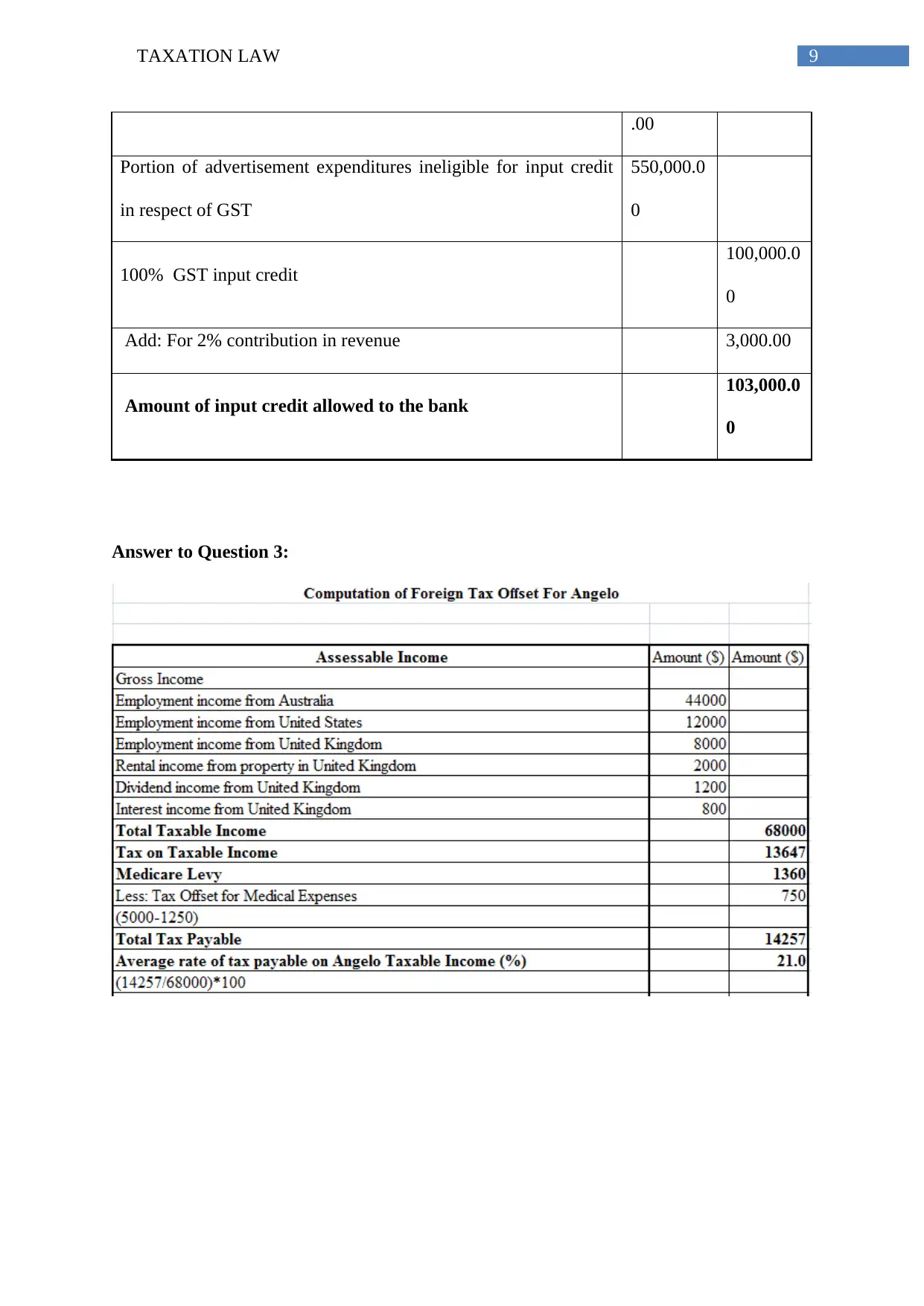
9TAXATION LAW
.00
Portion of advertisement expenditures ineligible for input credit
in respect of GST
550,000.0
0
100% GST input credit
100,000.0
0
Add: For 2% contribution in revenue 3,000.00
Amount of input credit allowed to the bank
103,000.0
0
Answer to Question 3:
.00
Portion of advertisement expenditures ineligible for input credit
in respect of GST
550,000.0
0
100% GST input credit
100,000.0
0
Add: For 2% contribution in revenue 3,000.00
Amount of input credit allowed to the bank
103,000.0
0
Answer to Question 3:
Paraphrase This Document
Need a fresh take? Get an instant paraphrase of this document with our AI Paraphraser
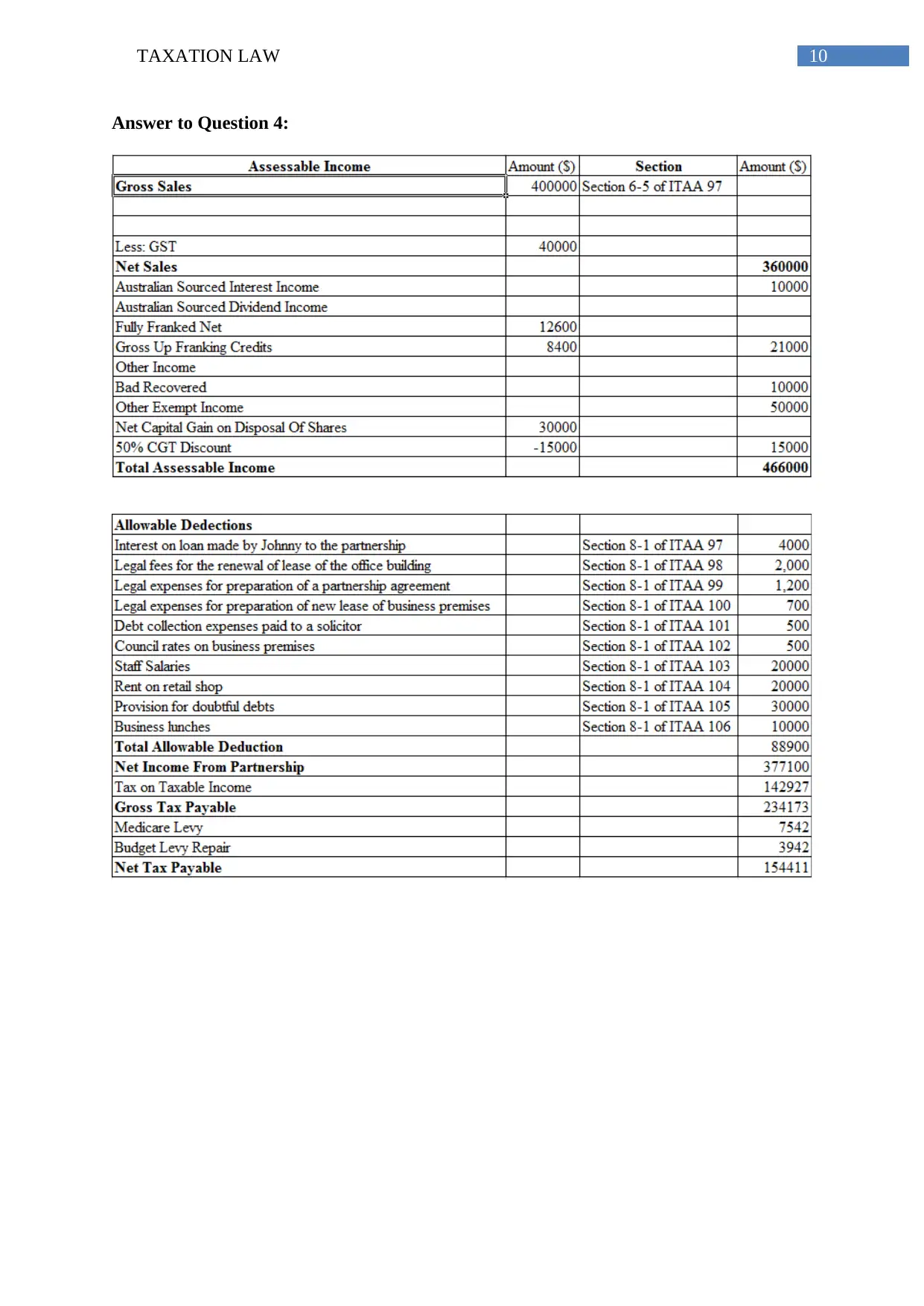
10TAXATION LAW
Answer to Question 4:
Answer to Question 4:
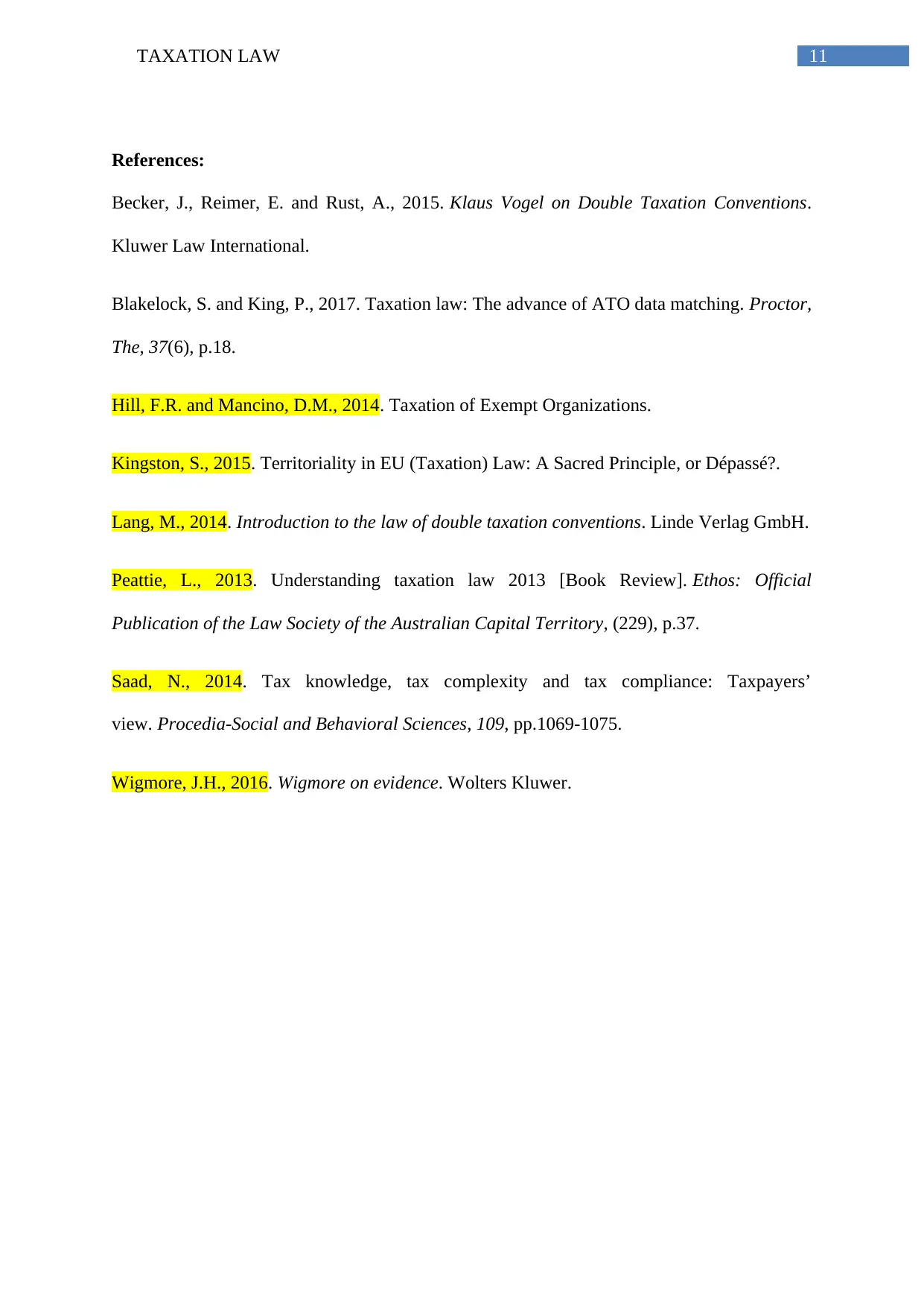
11TAXATION LAW
References:
Becker, J., Reimer, E. and Rust, A., 2015. Klaus Vogel on Double Taxation Conventions.
Kluwer Law International.
Blakelock, S. and King, P., 2017. Taxation law: The advance of ATO data matching. Proctor,
The, 37(6), p.18.
Hill, F.R. and Mancino, D.M., 2014. Taxation of Exempt Organizations.
Kingston, S., 2015. Territoriality in EU (Taxation) Law: A Sacred Principle, or Dépassé?.
Lang, M., 2014. Introduction to the law of double taxation conventions. Linde Verlag GmbH.
Peattie, L., 2013. Understanding taxation law 2013 [Book Review]. Ethos: Official
Publication of the Law Society of the Australian Capital Territory, (229), p.37.
Saad, N., 2014. Tax knowledge, tax complexity and tax compliance: Taxpayers’
view. Procedia-Social and Behavioral Sciences, 109, pp.1069-1075.
Wigmore, J.H., 2016. Wigmore on evidence. Wolters Kluwer.
References:
Becker, J., Reimer, E. and Rust, A., 2015. Klaus Vogel on Double Taxation Conventions.
Kluwer Law International.
Blakelock, S. and King, P., 2017. Taxation law: The advance of ATO data matching. Proctor,
The, 37(6), p.18.
Hill, F.R. and Mancino, D.M., 2014. Taxation of Exempt Organizations.
Kingston, S., 2015. Territoriality in EU (Taxation) Law: A Sacred Principle, or Dépassé?.
Lang, M., 2014. Introduction to the law of double taxation conventions. Linde Verlag GmbH.
Peattie, L., 2013. Understanding taxation law 2013 [Book Review]. Ethos: Official
Publication of the Law Society of the Australian Capital Territory, (229), p.37.
Saad, N., 2014. Tax knowledge, tax complexity and tax compliance: Taxpayers’
view. Procedia-Social and Behavioral Sciences, 109, pp.1069-1075.
Wigmore, J.H., 2016. Wigmore on evidence. Wolters Kluwer.
⊘ This is a preview!⊘
Do you want full access?
Subscribe today to unlock all pages.

Trusted by 1+ million students worldwide
1 out of 12
Related Documents
Your All-in-One AI-Powered Toolkit for Academic Success.
+13062052269
info@desklib.com
Available 24*7 on WhatsApp / Email
![[object Object]](/_next/static/media/star-bottom.7253800d.svg)
Unlock your academic potential
Copyright © 2020–2025 A2Z Services. All Rights Reserved. Developed and managed by ZUCOL.





